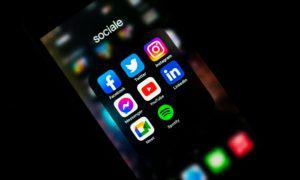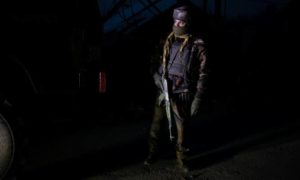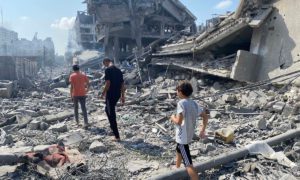Recent tensions between India and Pakistan saw mainstream and social media taking a vanguard while screaming “revenge” through characters. Amid heightened tensions, twitter became a new battleground, where hashtags were missiles, and trolls, the combatants.
The advent of the virtual Twitter MeToo hashtag that spurred action against sexual harassers in and outside workplaces across different countries led social media to be hailed as a stage to accommodate and spur positive, and (less noted) negative, change in a common person’s life.
Even so, hashtags and 148 characters were enough to express one’s frustration in matters regarding politics, society, personal and professional events. However, with powerful politicians jumping on Twitter wars, virtual words acquired actual significance over the coming years.
One of the most defining moments of the power of a simple Instagram handle was when Iranian Foreign Minister Javaid Zarif, notably the architect of the Iran nuclear deal struck with the U.S in 2015, resigned in a post on the site a week before, rejected a while later by reformist President Hassan Rouhani.
Furthermore, United States’ President Donald Trump’s partnering with social media site Twitter for exclusive political communication since he won the election has also provided a positive narrative toward such networks.
The main idea is to lessen the belief that so-and-so, in their big offices and with their hot-shot international colleagues, are beyond one’s reach or understanding. Rather, they’re people who’ve been elected by other people to represent them on the world stage.
Notably, the dance of democracy runs on the engine of transparency and accountability which social media has perpetuated in the few years its gained traction. Nations miles apart can gauge a transient enemy’s stronghold with a whiff of a few sentences. The Art of Social Media War, as modern-day Sun Tzu would put it, is to know oneself and one’s enemy with the kind of language s/he chooses to use during rebuttals.

Reactions
It’s not premature to highlight, therefore, the recent events in actuality that triggered trends and sparked attacks disguised in characters. While Indians and Pakistanis mulled over a hundred possibilities of war, following Prime Minister of India Narendra Modi’s speech targeting Pakistan for the attack on a CRPF convoy in Pulwama district of Jammu and Kashmir that killed 49 CRPF personnel claimed by the militant outfit Jaish-e-Mohammad (JeM), shots were fired by both sides on Twitter.
In retaliation, New Delhi launched “pre-emptive” strikes across the Line of Control targeting “terror camps” of JeM on February 26. As one India Today article put it, ‘Twitter was abuzz with celebratory posts, with some even asking for leave from office to soak in the excitement’.
Hashtags like #SurgicalStrike2.0 or #IndiaStrikesBack were one of the top trends.
Kids sent this on whatsapp 👇
👮♂️- “How’s the Jaish” ??
🙋♀️🙋♂️”Dead Sir” #Surgicalstrike2— Major Surendra Poonia (@MajorPoonia) February 26, 2019
What #IndianAirForce Did With Jaish-e-MOHAMMED 🤣🤣🤣#PremiumEconomySale#Abhinandan#BringBackAbhinandan#SayNoToWar#NationFirst#SayNoToTerrorism#surgicalstrike2pic.twitter.com/UggQbqHm1U
— Arnab Dutta(अर्णवदत्ता) (@Arnab_Dutta1) February 27, 2019
“Humari INDIAN Fauj ko ungli maat karo..varna hath ukhadne may ab der nahi karegi”
Those who asking for proof about #SurgicalStrike2 should be tied with missile & bombard them on Pakistani soil then only they will believe it.#NamoAgain
Jai hind pic.twitter.com/vZl1cbH2lZ— Chintan Choksi (@_ChintanChoksi) March 4, 2019
This pic has huge fan base in India. #SurgicalStrike2pic.twitter.com/y8TN9DaLVk
— Raghuveer@BJP 🇮🇳 (@raghuveer5307) March 1, 2019
After #SurgicalStrike2 by #IAF Pakistani’s situation be like :- pic.twitter.com/RaHn1inld1
— Loser🖤🔥 (@Akhand_Savage) March 3, 2019
NO! This is not a meme From Future.
This is an Upcoming Movie of Sanjay Leela Bhansali. #AbhinandanVarthaman#SurgicalStrike2pic.twitter.com/ZNUr7dA2p4— Muhammad Salman (@iam5alman) March 4, 2019
The next morning, Pakistan launched ‘retaliatory airstrikes across the LoC’, capturing an Indian Air Force Wing Commander Abhinandan Varthaman. Calling him ‘a prisoner of war’, Abhinandan was hailed as a hero and a courageous fighter, released later on Friday as a ‘gesture of peace’ from Pakistan.
#BringBackAbhinandan and later #WelcomeHomeAbhinandan topped Twitter trends, with the pilot’s replies to the Pakistani Army in an Inter-Services Public Relations (ISPR) video being lauded as his ‘bravery in the face of adversity’.
How proud we are to have you ! Bow down to your skills and even more your grit and courage #WelcomeBackAbhinandan . We love you and are filled with pride because of you.#WeAreSupposedToTellYouThispic.twitter.com/IfqBFNNa3T
— Virender Sehwag (@virendersehwag) March 1, 2019
“I am not supposed to tell you that….” This dialogue deserves a Gallantry Award…#welcomehomeabhinandanpic.twitter.com/P93OpIP9FY
— sivaji (@sathvik_96) March 1, 2019
Q : What’s the bravest line have you ever heard?
Ans : I am not supposed to tell you this!#WelcomeHomeHeropic.twitter.com/C0pFpKjtBO— Vishal (@vishal_nagan) March 1, 2019
“I am not supposed to tell you this” #WelcomeBackAbinandanpic.twitter.com/ki95KKdcFc
— Avinash Karthikeyam (@lovecodeerror) March 1, 2019
Welcome Back Champion! India will never forget these words ‘I am not supposed to tell you this’. Jai Hind#WelcomeHomeAbhinandanpic.twitter.com/Gt3nYxuiB4
— Shivendra Pratap Singh (@shivendralive) March 1, 2019
Pakistan versus Indian Media
Amidst all the bravado and ‘Let’s show Pakistan what we’re made of’ slogans, nations, editorials and analysts called for ‘maximum restraint’ to be showed between both parties, and for dialogue to take the center stage of discussions. Hashtags like #SayNotoWar trended side-by-side with #SurgicalStrike2.0, showing two facets of Indian thought emerging among the ruins.
Associate Editor of the Indian Express, Pratik Kanjilal, underlined ‘rechristening’ of Indian newsrooms into ‘war rooms’ and the different stances news corporations took on the pilot’s release.
‘Times Now: “Blackmail falls flat.” NewsX: “No deal, Pak folds in fear.” India Today Live: “India gets hero back: Massive victory for India.” Back to Times Now: “Will the pro-Pakistan lobby accept that pressure not pampering works against Pakistan?” ’
Pratik Sinha, co-founder of Alt-News, a fact checking website, tweeted:
Sab TV channels waale seem to get their weed from the same source. pic.twitter.com/QcUUvhagT3
— Pratik Sinha (@free_thinker) February 28, 2019
In the battle of perceptions, retired Indian Army Colonel Ajai Shukla agreed that Pakistan won ‘for now’, stating that things had ‘moved on’ from the past fifty years. Few attributed the same to Modi’s handling of the media, stating that he chose to ‘broke into poetry’, in contrast to Pakistani premier’s ‘hands-on approach’.
Despite both countries shifting the blame and loss at each other’s desks while lauding the media for its decisive role during the situation, fact and fake news jumbled together in testimonies from unnamed sources, further fueling the already delicate situation.
Media personality and film producer Pritish Nandy observed the same in a tweet: “I am a little confused as to who is fighting the war against Pakistan. The brave Indian army or the shrieking TV journalists out to show their fake nationalism?”
I am a little confused as to who is fighting the war against Pakistan. The brave Indian army or the shrieking TV journalists out to show their fake nationalism?
— Pritish Nandy (@PritishNandy) February 28, 2019
Senior Media executive and business professional Sameer Nair, tweeted:
— Sameer Nair (@nairsameer) February 28, 2019
Vijeta Mandavgane, wife of Ninad Mandavgane, one of the six Indian Air Force officers killed in an IAF helicopter crash in Budgam, Jammu and Kashmir, in a Facebook post stated: “I ask Facebook warriors to stop conducting war on Facebook and (other) social media. Nothing will come of this. If you have so much josh, join the armed forces, or ask your family members to do so and then face the reality. We do not want war; you have no idea about the destruction a war brings…no other Ninad should go, from either side.”
A programme on the Qatar-based news channel Al-Jazeera, The Listening Post, states that whenever an incident such as the Pulwama attack occurs, before the government or the army of a country can respond, the media immediately jumps the gun, asking for war.
“The coverage on 24 hour news channels has been wall-to-wall, which is editorially defensible, but descends into un-journalistic ranting, especially during Prime Time,” the host, a Canadian broadcast journalist, Richard Gizbert narrates. “Because for the Indian news media, this ticks so many boxes- Kashmir, Pakistan, the Army and the attack came just as campaigning begins for a national elections that is just months away.”
In retrospect, social media’s ‘extensive penetration’, with regards to schemes and programmes placed by Narendra Modi, and the ‘creation of filter bubbles and echo chambers, enabling the quick and pervasive spread of polarising politics, especially by political parties that are flush with funds’, has led to the increased possibility of an immediate communal conflict, notes visiting Fellow at Institute of Asian Studies in Hamburg, Dr. Sangeeta Mahapatra.
Her comments arrived before the widespread harassment, abuse and rustication of Kashmiris across India, fueled by the Twitter hashtag #IndiaWantsRevenge.

A mobster trying to enter a college premise in Dehradun demanding rustication of Kashmiri students.
“The attack has provoked first of all, a national outpouring of grief on mainstream media channels, and the spewing of lots of venom against various targets, particularly against Pakistan, but also against Kashmir,” Shakuntala Banaji, Associate Professor in the Department of Media and Communications at London School of Economics said in the AJ video.
While on social media, the students studying outside were receiving threats and abusive messages, various Kashmiri students from Jammu told Free Press Kashmir over telephone that they were many times rescued by Hindu friends when the mob was going hay-wire, despite the imposition of curfew.
“I was in Janipur. I wasn’t feeling safe there. I thought about going to my aunt’s place. A Hindu friend helped me. I took the Indian Flag in my hand and we crossed the crowd protesting,” said a Kashmiri student.
Rohit Chopra, Associate Professor in Santa Clara University stated: “With the exception of a few sane voices, what you have is a completely absurd and very dangerous comparative jingoism that is perennially on display from all these anchors. The anchors actually play a pretty strong role in shaping public opinion and in the present moment, their reaction is all the more dangerous.”
Media and the State
A scene from an alternate reality in the TV series, The Man in the High Castle, which explores how the world might look like had the outcome of World War II turned out differently, namely the victory of the Axis Powers, shows two characters in the ‘Neutral Zone’ where ‘American War propaganda’ was never taken down.

A scene from ‘man in the high castle’.
Much alike the above, in the Cold War between the US and the USSR in the mid- to late-eighties, the media consisted of print, film, radio and TV and was focused on developing and distributing political propaganda. It’s important to note, that unlike today’s decentralized electronic media, the media at that point of time was highly susceptible to state control.
“The initial role the media took was to motivate the post-WW2 populace into reaffirming and defending their national political and economic allegiances. While the private-owned Western media was obliging in the defence of Western economic and military interests, the state-censored soviet media was just as ready to defend theirs. All media succeeded in the production of public support for their government’s actions against the foreign enemy. The Western Allied governments and the Soviet Union could never have produced or maintained sufficient public support and jingoism for the long conflict without the media’s contribution (Doherty, 2003).”
According to ‘The Role of the Media During the Cold War’, by Alexander Stafford, the Western media’s ‘The Red Scare’ campaigns were presented on the media at every possible turn, ‘with easily decodable and emotive images helped to redefine national identity as a virtuous and patriotic America, against a dangerous and destructive socialist east. The media distributed extreme propagandist slogans such as “Better Dead than Red!” This type of politicised propaganda served to cause hysteria over communism and nuclear war (Bernhard, 1999)’.

Communists were often referred to as “Reds” for their allegiance to the red Soviet flag.

During this time, Americans became extremely paranoid over the ‘threat of Communism’ and arrived at the conclusion that the communists had ‘obtained the secret blueprints for atomic bomb production’.


Accordingly, posters such as above circulated by the media were considered as a ‘calculative action’ to maintain public antagonism towards the enemy and rejection of their political and economic policies.
“The media extended the propaganda to every aspect of western life, from radio, film, television and print to even schools. The film “Red Nightmare” was taught as part of the standard curriculum and is evidence of the media providing state-sanctioned indoctrination of the populace.”

A scene from the Red Nightmare.
The plot of the movie revolves around an American man who awakens to find communist forces have taken over the United States.
A different adornment, yet a similar underlying message harrows out on social media and on micro-blogging site, Twitter. While the common man breathes cautiously a sigh of relief in reality, things on the social media platform seem much like a call for war.
.final stroke required #India#Balochistan#Pakistanpic.twitter.com/9FapV98fow
— Archen Baloch (@ArchenBaloch) March 5, 2019
Indeed, #Pakistan& people of Pakistan are desperately wanting peace with India. Listen to this girl and imagine who has taught Peace Sermons in Pakistan
Be Like Imran Khan, Be Like Statesman. Keep hating Modi because your kids would not get chance to hate anyone like this kid pic.twitter.com/3QfcDdKiaM
— Sauhard Jain (@JainSauhard) March 5, 2019
Shocking report on Twitter, 58% of GoBackModi tweets are from Pakistan https://t.co/cW7n9NO0Pw#GoBackModi#Pakistan#PMModi#Twitter via @rightlog_in
— S Gurumurthy (@sgurumurthy) March 5, 2019
Agents of #Pakistanpic.twitter.com/dsuko85FNJ
— पूर्णेन्दु (@IamPurnenduJha) March 5, 2019
LOOOOOOOOL too funny yaar, too funny
–#india#pakistan#balakot#abhinandhan#theteaisfantastic#makechainotwar#pakistannavy#saynotowar#indianmediapic.twitter.com/zeSHIDJQ28— MangoBaaz (@mangobaaz) March 5, 2019
Trolling level infinity #WhyTheyHateModi#TuesdayThoughts#Pakistanpic.twitter.com/RxASjv6fdz
— Ayesha Jahanzeb (@AyeshaJ_GEO) March 5, 2019
#Pakistan Air Force operated here, enter upon your own risk pic.twitter.com/SHnGKMYtex
— Pakistan Defence (@DefencedotPak) March 5, 2019
1: In #Pakistan, a ruling party Minister runs his foul mouth against minority #Hindus: Gets FIRED!
2: In #India, a Chief Minister murders thousand of #Muslims, continues to torment: Gets elected PM by the Hindu majority.
3: If you can’t see a difference, you’ve got to be blind.
— Shahid Raza. (@schaheid) March 6, 2019












